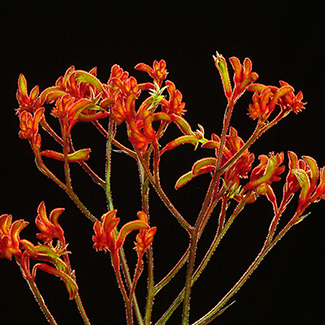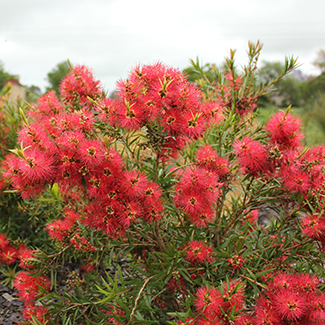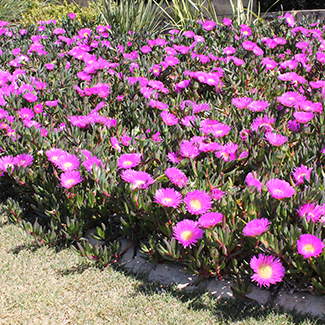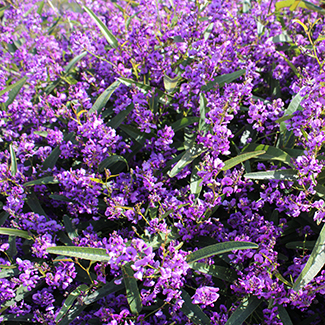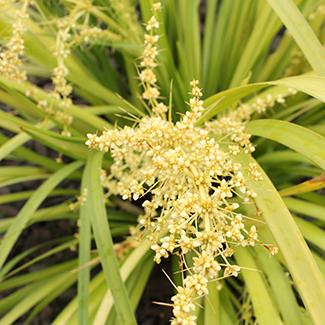Did you know that there is a vast range of bold Australian natives that can add that burst of colour you desire in your garden without the added maintenance of exotics?
One of the most stunning features of Australian natives is their prominent looks and splendour. Many of our plants are strictly unique to Australia and are improved forms with tidier foliage, better flowers and usually a more compact form, which in turn makes them the ideal choice for any bold native garden.
Native plants have already adapted to our environment, this means that once a native garden is established, it requires much less water to maintain and keep looking healthy than other exotic gardens and plants. They are very easy to grow and native plants can tolerate local climatic extremes such as frost and periodic drought.
Anigozanthos ‘Gold Velvet’ is a very tough, mid-sized plant that has beautiful dark green foliage, with masses of bold, lavish golden flowers that will grow to approximately 1 metre tall for most of the year. Anigozanthos ‘Regal Velvet’ has magnificent red flowers with green highlights that can reach up to 1 metre to 1.4 metres tall. It is very tough and requires less trimming than some other Kangaroo Paw varieties.
Anigozanthos ‘Amber Velvet’ has amazing vivid amber coloured flowers that really set gardens alight with colour. Its robust foliage makes it a real feature in any garden. Ruby Velvet™ anigozanthos is the smallest of these 4 tough Kangaroo Paws. It is ideal for front gardens and even makes a great garden border. With its vibrant, bold ruby coloured flowers the Ruby Velvet™ plant will make a pleasing addition.
Unlike the small pot culture Kangaroo Paws which behave like annuals, the Velvet range of Kangaroo Paws are long lived varieties with improved disease tolerance. They are mid-sized types with strong flavidus genes.
Gold Cluster™ grevillea is a beautiful ground cover with masses of spider like stunning gold flowers in winter and spring. It is lower growing, has a denser form and grows to half the height of other popular forms. Cherry Cluster™ grevillea is a semi-prostate ground cover that boasts masses of small bold red flowers throughout autumn, winter and spring. It has very clean and tidy foliage and adds a wonderful burst of cherry red to any native garden. Crimson Villea™ grevillea is one of the showiest winter flowering plants in the world. It is a tough, compact shrub grevillea with tidy foliage and an abundance of crimson flowers in autumn, winter and early spring.
Flora Burst™ callistemon is a real show stopper with masses of red bottlebrush flowers in spring. Generally the Flora Burst™ plant has more flowers than most other callistemon varieties and in many parts of Australia is a repeat bloomer in autumn. As an added feature this shrub also displays rustic red new growth on its foliage in spring and autumn adding a touch of colour almost all year round. Scarlet Flame™ callistemon is an ultra-compact fine leaf callistemon featuring rustic red new growth in spring and autumn. It also has beautifully delicate flowers that along with new growth provide a more colourful plant for a longer period. Slim™ callistemon is a bottlebrush solution for tight planting areas with its unique growth habit. A large number of flowering buds develop in spring and open up to a classic bottlebrush throughout spring, summer and later again in autumn. With its beautiful bold red flowers, the Slim™ plant is an ideal choice for colour in a native garden with tight planting space. Red Alert™ callistemon is a compact callistemon that is low maintenance and a native alternative to Photinia. It has vibrant, vivid red foliage for 2 months in autumn and 2 months in spring and lighter new growth in other months. Macarthur™ callistemon incorporates two of the most popular varieties on the market. Little John and Captain Cook, but providing a more compact growth habit and better flower presentation. It has very fresh green foliage with a bushy, tidy growth and masses of delightful, bold red flowers in spring, then sporadically in autumn. Better John™ callistemon is bred from Little John although is easier to grow, quicker to establish and has better colour foliage than Little John. Its foliage has a blue-green tone when mature, new growth has a silver coloured tone due to its soft hairy texture. The Better John™ plant starts flowering with beautiful small red flowers in mid spring and finishes late spring. Green John™ callistemon has light green new growth contrast beautifully with its darker green mature foliage and its red flowers and is also a wonderful contrast to Better John™ callistemon. It flowers from September to November with small red bottlebrush flowers. The Green John™ plant is denser and faster growing than Little John.
Aussie Rambler™ Carpobrotus glaucescens ‘CAR10’ PBR is a prostate creeping succulent that has long trailing stems that can reach up to 2 metres long. What makes the Aussie Rambler™ plant an ideal ground cover for any bold native garden is its large, deep pink flowers that can reach up to 14cm in diameter. Unlike the common form, Aussie Rambler™ carpobrotus handles heavy soils far better, and is a lot more cold tolerant.
Blue Gem™ Westringia ‘WES03’ PBR has vivid, almost fluorescent blue/purple flowers and is one of the best flowering Westringia’s available. The Blue Gem™ plant has an attractive bushy growth that responds well to pruning, it works well as a feature shrub and is very well suited to any native garden.
Purple Fusion™ Scaevola humilis ‘PFS100’ PBR is a true Scaevola ground cover that does not mound like other varietes, therefore grows much flatter and requires less cutting back. The Purple Fusion™ plant has an abundance of purple lilac flowers all year round but flowers heaviest from September to December. The perfect native plant to add a bit of colour all year round.
Meema™ Hardenbergia violacea ‘HB1’ PBR has an upright form and grows into a shrubby ground cover, and it will creep up things if allowed to. The Meema™ plant has masses of purple flowers from July to September and keeps a crisp clean foliage better than other forms through very cold winters and hot dry periods. It maintains a very tidy form even when unpruned, but with yearly pruning or even twice yearly pruning, it will maintain a very tidy hedge appearance.
Shara™ Lomandra fluvialtilis ‘ABU7’ PBR is an incredible fine leaf Lomandra that has a tidy compact from with blue grey tones to the foliage and masses of vibrant yellow flowers that sit above the foliage. The Shara™ plant has more flowers than most other Lomandra fluvialtilis forms, it is drought tolerant, evergreen, does not produce seed and is soft to touch. Shara™ lomandra is very root rot resistant, meaning it will thrive in humid climates, and can handle periodic wet feet.
Katie Belles™ Lomandra hystrix ‘LHBYF’ PBR is a full sized Lomandra hystrix with masses of prolific bold yellow flowers through spring for months at a time. It also has the added bonus of a sweet perfumed smell.
Tropic Cascade™ Lomandra hystrix ‘LHWP’ PBR has beautiful green weeping foliage, large fragrant male flowers that will not produce seed. It is a more compact form that tolerates drought and humidity.
The benefits of choosing Australian native plants for bold colour in your garden are extensive, not only for the sheer enjoyment from their picturesque beauty, but they also offer a haven for native wildlife, providing the right habitat and food for native animals, birds and insect populations. This attracts nectar feeding birds, butterflies etc. and brings even more pleasure and delight to any garden. It should also not be overlooked that Australian native plants are an integral part of our heritage, and by continuing to grow and propagate them in our backyards and gardens, we are able to contribute to their preservation.
<< Back to Articles Home Page Landscaping Articles Native Plant & Turf Articles Full List of Articles

